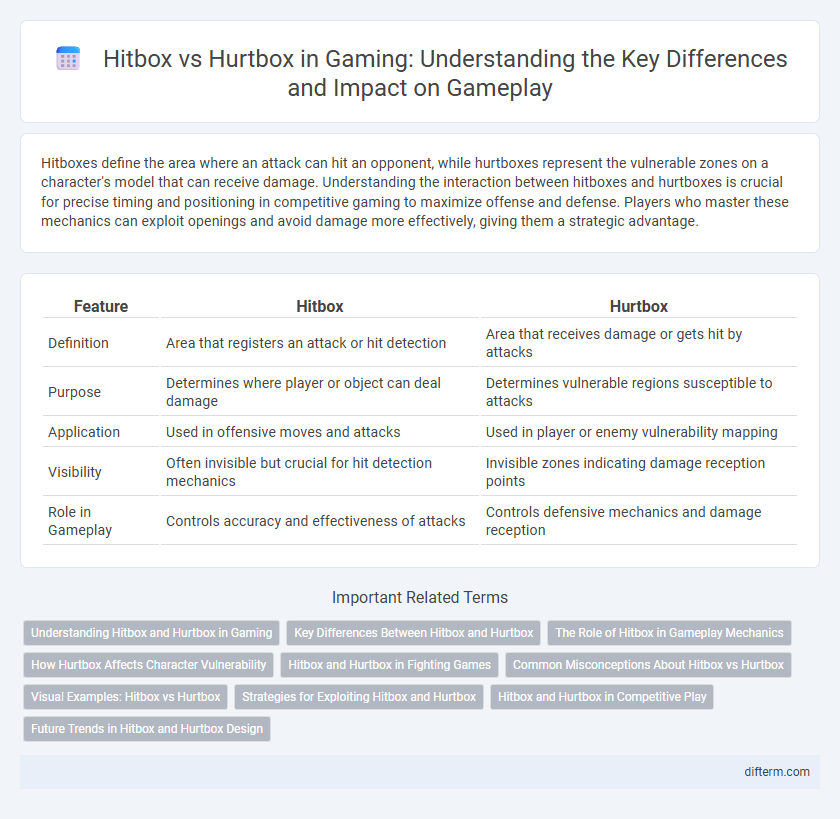Hitboxes define the area where an attack can hit an opponent, while hurtboxes represent the vulnerable zones on a character's model that can receive damage. Understanding the interaction between hitboxes and hurtboxes is crucial for precise timing and positioning in competitive gaming to maximize offense and defense. Players who master these mechanics can exploit openings and avoid damage more effectively, giving them a strategic advantage.
Table of Comparison
| Feature | Hitbox | Hurtbox |
|---|---|---|
| Definition | Area that registers an attack or hit detection | Area that receives damage or gets hit by attacks |
| Purpose | Determines where player or object can deal damage | Determines vulnerable regions susceptible to attacks |
| Application | Used in offensive moves and attacks | Used in player or enemy vulnerability mapping |
| Visibility | Often invisible but crucial for hit detection mechanics | Invisible zones indicating damage reception points |
| Role in Gameplay | Controls accuracy and effectiveness of attacks | Controls defensive mechanics and damage reception |
Understanding Hitbox and Hurtbox in Gaming
Hitbox and hurtbox are crucial concepts in gaming that define interaction zones for attacks and damage reception; a hitbox refers to the area where an attack can hit, while a hurtbox represents the vulnerable region of a character that can receive damage. Accurate understanding of hitbox and hurtbox mechanics enhances precision in combat scenarios, influencing gameplay strategies and character balancing. Developers use hitbox and hurtbox data to create fair and responsive gaming experiences, ensuring that player actions lead to predictable and skill-based outcomes.
Key Differences Between Hitbox and Hurtbox
Hitboxes define the exact area where an attack can hit, representing the offensive range of a character's move, while hurtboxes indicate the zones where a character can be damaged, essentially marking vulnerability points. The key difference lies in their function: hitboxes are active elements used to deal damage, whereas hurtboxes are passive and denote where a character can be struck. Understanding the interplay between hitbox and hurtbox is crucial for mastering timing and spacing in competitive gaming.
The Role of Hitbox in Gameplay Mechanics
Hitboxes define the precise area where a character's attack can connect, directly influencing the effectiveness and timing of offensive moves in gameplay mechanics. Accurate hitbox design ensures balanced interactions between player actions and enemy vulnerabilities, creating fair and engaging combat scenarios. Understanding hitbox mechanics is crucial for mastering hit detection and optimizing attack strategies in competitive gaming environments.
How Hurtbox Affects Character Vulnerability
The hurtbox defines the area of a character that can be damaged by opponents' attacks, directly influencing their vulnerability during gameplay. Characters with larger or poorly positioned hurtboxes are more susceptible to incoming hits, affecting their defense and evasion strategies. Precise understanding of hurtbox dimensions allows players to optimize positioning and timing to minimize exposure and maximize survival in competitive gaming.
Hitbox and Hurtbox in Fighting Games
Hitboxes in fighting games define the area where an attack can hit an opponent, while hurtboxes represent the vulnerable zones on a character's body that can be struck. Precise alignment of hitboxes and hurtboxes is crucial for balancing gameplay and ensuring fair detection during combos and counters. Understanding the interaction between these elements enhances competitive strategies and improves player timing and positioning.
Common Misconceptions About Hitbox vs Hurtbox
Many players confuse hitboxes and hurtboxes, mistakenly believing they are the same or function identically during gameplay. Hitboxes represent the area where an attack can deal damage, while hurtboxes define the vulnerable zones of a character that can be hit by opponents. Misunderstanding these concepts often leads to errors in timing and positioning, impacting competitive performance and game strategy.
Visual Examples: Hitbox vs Hurtbox
Hitboxes and hurtboxes are critical in gaming mechanics for defining attack and vulnerability zones, respectively. Visual examples often depict hitboxes as red or orange outlines surrounding weapons or attack areas, while hurtboxes are shown as translucent shapes around characters' bodies to indicate where damage can be received. Clear differentiation between hitboxes and hurtboxes in fighting games like Street Fighter or Super Smash Bros enhances player strategy by providing precise collision detection feedback.
Strategies for Exploiting Hitbox and Hurtbox
Effective strategies for exploiting hitbox and hurtbox dynamics in gaming involve precise timing and spatial awareness to target opponents' vulnerable zones while avoiding their attack range. Players must analyze the size and placement of hitboxes to anticipate hit registration and use hurtbox manipulation techniques, such as dodging or invincibility frames, to reduce incoming damage. Mastery over these mechanics enables players to optimize offensive moves and defensive positioning for competitive advantages in fast-paced game environments.
Hitbox and Hurtbox in Competitive Play
In competitive gaming, precise understanding of hitboxes and hurtboxes is crucial for player performance and strategy. Hitboxes represent the area where an attack can hit an opponent, while hurtboxes indicate the vulnerable zones where a character can be damaged. Mastery of these concepts allows players to optimize offensive moves and defense, significantly impacting reaction times and match outcomes.
Future Trends in Hitbox and Hurtbox Design
Advancements in machine learning and AI are revolutionizing hitbox and hurtbox design, enabling ultra-precise collision detection that enhances gameplay fairness and immersion. Procedural generation techniques are being integrated to create dynamic and adaptive hitboxes that respond to character movements and environments in real-time. The shift toward virtual reality and augmented reality gaming is driving the development of three-dimensional, fully interactive hurtboxes that align seamlessly with player actions and physical space.
hitbox vs hurtbox Infographic

 difterm.com
difterm.com